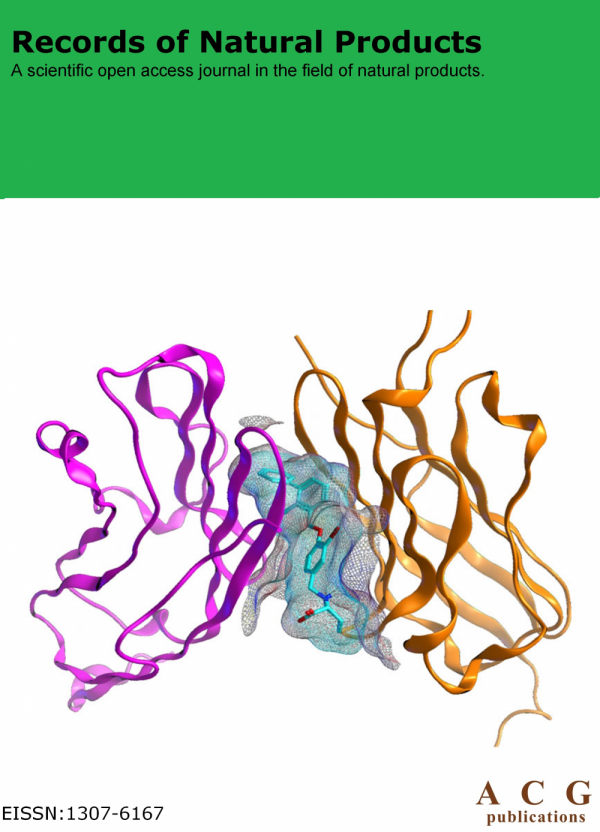Records of Natural Products
Year: 2023 Volume: 17 Issue:5 September-October
1) Traditional Uses, Phytochemistry and Pharmacological Properties of Strobilanthes crispa (L.) Blume.
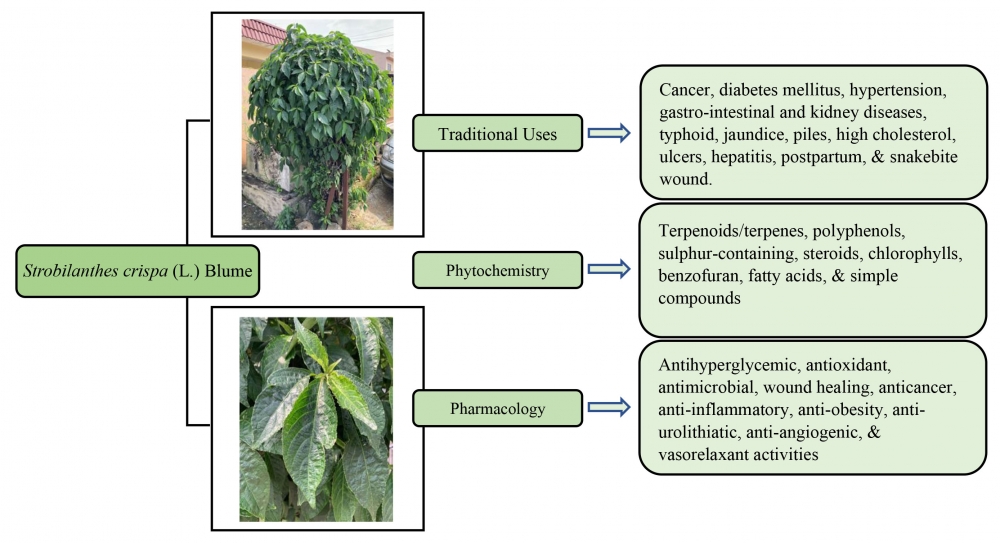
Strobilanthes crispa (L.) Blume (S. crispa) is a folklore medicinal plant of the genus Strobilanthes (Acanthaceae), traditionally used in Malaysia and Indonesia to treat various diseases such as breast and uterine cancers, diabetes mellitus, hypertension, gastrointestinal and kidney diseases, typhoid, jaundice, piles, high cholesterol, and ulcers. Several studies have shown that S. crispa contains a variety of phytochemicals, including terpenoids, flavonoids, phenolic compounds, sulfur-containing, steroids, chlorophylls, benzofuran, fatty acids, and other simple metabolites. Furthermore, based on its traditional uses, S. crispa has demonstrated a wide range of in vitro and in vivo pharmacological activities. These activities include antihyperglycemic, antioxidant, antimicrobial, wound healing, anticancer, anti-trypanosomal, anti-inflammatory, anti-obesity, anti-urolithiatic, anti-angiogenic, and vasorelaxant activity. The paper aims to provide a comprehensive review of the current understanding of traditional use, toxicity, phytochemicals, and pharmacological studies of S. crispa, thereby validating its ethnopharmacological applications and exploring possible research opportunities.
DOI http://doi.org/10.25135/rnp.402.2305.2785 Keywords Strobilanthes crispa Acanthaceae traditional uses phytochemistry pharmacology DETAILS PDF OF ARTICLE © 2023 ACG Publications. All rights reserved.2) Traditional Use, Pharmacology and Toxicology of the Lignans in Genus Kadsura: A Systematic Review
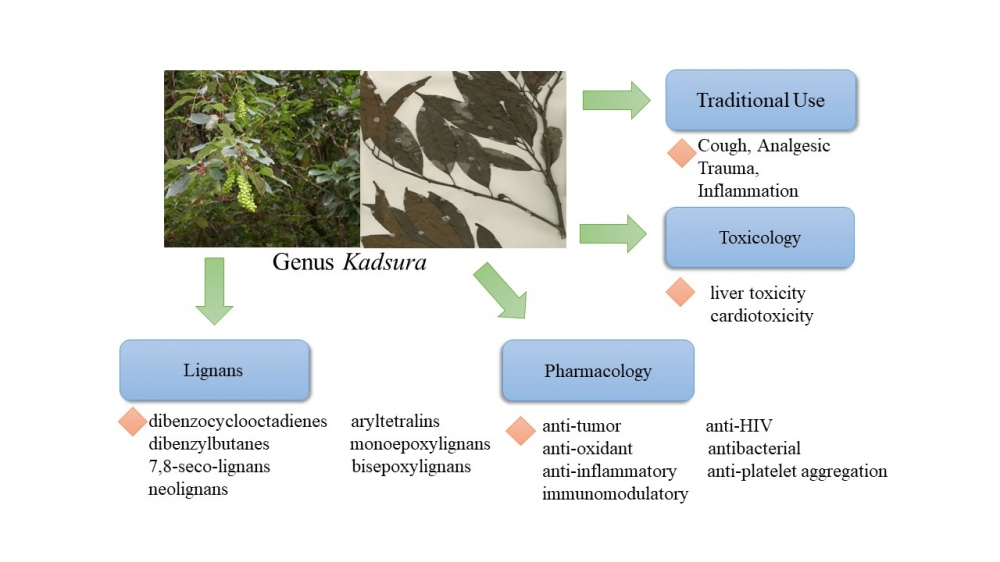
The genus Kadsura is an important part of traditional Chinese medicine, it has the functions of promoting wind, eliminating dampness, activating blood circulation. Modern pharmacological studies have shown that lignans are one of the main components to possess these medicinal effects. This review aimed to provide a systematic summary on the traditional use, phytochemistry, pharmacology, toxicology and other aspects of lignans in genus Kadsura. In this paper, we collected the relevant literature on Kadsura lignans from 1973 to the present, and isolated more than 337 lignans from this genus, including dibenzocyclooctadienes, aryltetralins, tetrahydrofurans, diarylbutanes, 7,8-seco-lignans, bisepoxylignans, neolignans, seco-dibenzocyclooctadienes, sesquilignan and coumarin-containing lignan. Previous pharmacological studies have shown that lignans of the genus Kadsura have antitumor, anti-inflammatory, antibacterial, anti-HIV, anti-platelet aggregation, immunomodulatory and antioxidant effects. In clinical practice, it is commonly used to treat Alzheimer's disease, inflammation and insomnia. Kadsura is an important part of the field of Chinese medicine and is widely used in traditional medicine. However, further clarification of its active ingredients and mechanism of action and the establishment of a complete quality standard system are needed in order to provide a scientific basis for in-depth studies of this genus.
DOI http://doi.org/10.25135/rnp.403.2304.2765 Keywords Kadsura traditional use Lignans pharmacology toxicity DETAILS PDF OF ARTICLE © 2023 ACG Publications. All rights reserved.3) NO Inhibitory, Farnesoid X Receptor, and Cytotoxic Activities of Phytochemical Composition Isolated from Aglaia perviridis
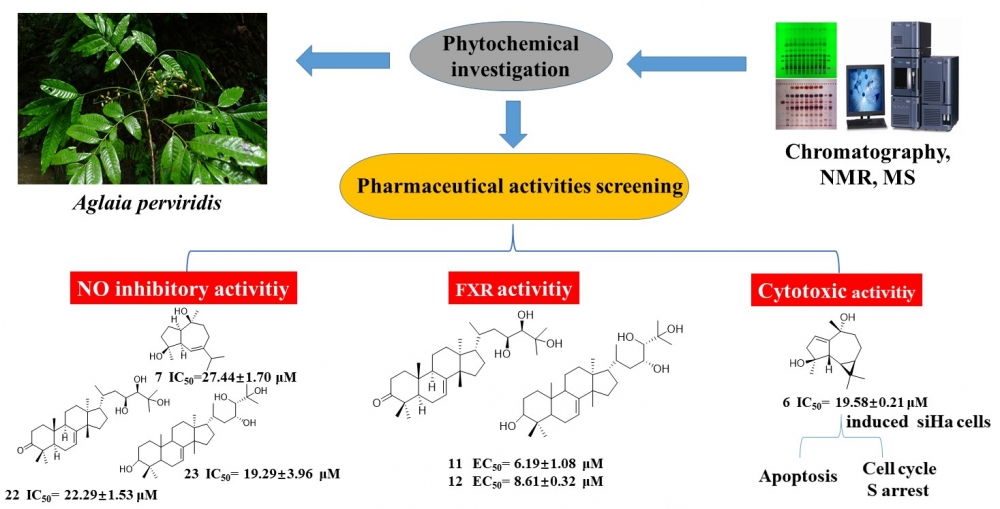
To search for novel and bioactive agents from the genus Aglaia, phytochemical investigation on the leaves and twigs of A. perviridis was performed, leading to the isolation of twenty-six compounds. Their structure was determined mainly by the NMR, ESI-MS spectra data, and by comparison with previously described compounds. Compounds 6–8, 11–13, 16, 18–20, and 22–26 were firstly reported from Aglaia perviridis. Besides, the NO inhibitory, Farnesoid X receptor, and cytotoxic activities of selected compounds were firstly evaluated. 1αH,5αH-guaia-6-ene-4β,10β-diol (7), 2'-hydroxy-4,4',6'-trimethoxychalcone (22), and 3-hydroxy-5,7,4'-trimethoxyflavone (23) showed moderate nitric oxide inhibitory activity with IC50 values of 27.44±1.70, 22.29±1.53, and 19.29±3.96 µM, respectively; piscidinol A (11) and hispidol B (12) firstly showed moderate agonistic activities on Farnesoid X receptor with the EC50 values of 6.19±1.08 and 8.61±0.32 µM, respectively; Among these compounds, lochmolin F (6) exhibited the strongest cytotoxic effect on SiHa cells with the IC50 value of 19.58±0.21 μM. Further flow cytometry and western blot analysis demonstrated that lochmolin F (6) could induce cell apoptosis and S cell cycle arrest in the SiHa cells. These results first emphasized the potential of lochmolin F (6) as lead compound for developing anti-cancer drugs.
DOI http://doi.org/10.25135/rnp.395.2304.2756 Keywords Aglaia perviridis phytochemical composition anti-inflammatory FXR cytotoxic activities DETAILS PDF OF ARTICLE © 2023 ACG Publications. All rights reserved.4) Butenolide Derivatives from the Fungus Aspergillus terreus and Their-Glucosidase Inhibitory Effects
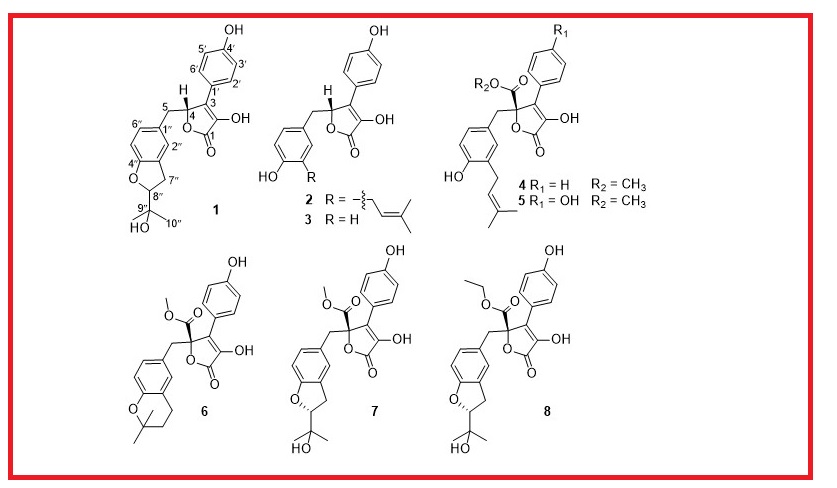
The strain was isolated from the sea sediment of Hangzhou Bay and was cultured on solid fermentation using rice bran. The fermented material was extracted with ethyl acetate. The chemical study of the extract led to the isolation of 8 butenolide derivatives (1-8). Their structures were elucidated by detailed analyses of spectroscopic techniques including 1D and 2D NMR and HRESIMS data. The absolute configuration of 1 was determined by comparing the experimental ECD curve of 1 with that of the computed ECD curves of a model molecule (1a). A butenolide derivative was originally misassigned to bear the same structure as that of 1, but it was later revised. Thus, the compound 1 was reported as a new compound and was named 4-demethyl ester aspernolide N (1). The known compounds were identified as 3-hydroxy-5-[[4-hydroxy-3-(3-methyl-2-buten-1-yl)phenyl]methyl]-4-(4-hydroxyphenyl)-2(5H)-furanone (2), 4-(4-hydroxyphenyl)-5-(4-hydroxyphenylmethyl)-2-hydroxyfurane-2-one (3), versicolactone B (4), butyrolactone I (5), aspernolide A (6), butyrolactone IV (7), aspernolide O (8). Bioassay study suggested that compounds 2-6 had better inhibitory effects on a-glucosidase than that of the positive control acabose with IC50 values ranging from 95 to 148 mM.
DOI http://doi.org/10.25135/rnp.398.2305.2786 Keywords Butenolide derivatives Aspergillus terreus Inhibitory effects on alpha-glucosidase DETAILS PDF OF ARTICLE © 2023 ACG Publications. All rights reserved.
5) Biological Activities of the Natural Coumarins from Apiaceae Plants
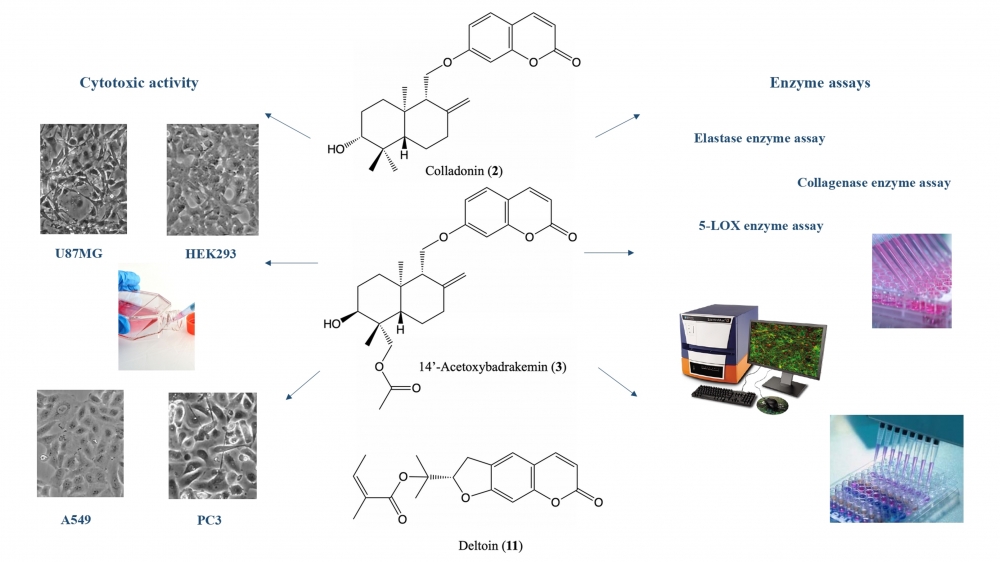
Nineteen natural coumarin derivatives; badrakemin (1), colladonin (2), 14'-acetoxybadrakemin (3), anatolicin (4), 14'-hydroxycolladonin (5), badrakemone (6), karatavicinol (7), 14'-acetoxybadrakemone (8), 14'-acetoxycolladonin (9), colladonin acetate (10), deltoin (11), smyrnioridin (12), isoimperatorin (13), oxypeucedanin (14), bergapten (15), osthol (16), 4'-senecioyloxyostol (17), neopapillarine (18), and scoparone (19) were tested against U87MG, A549, and PC3 cancer cell lines as well as against healthy human embryonic kidney cell line, HEK293. Colladonin (2) was found to have IC50 values of 12.6 and 11.58 µM in A549 and PC3 cell lines, respectively. Deltoin (11) and 14'-acetoxybadrakemin (3) were found to have an IC50 value of 9.92 µM and 11.85 µM against the U87MG cell line, respectively. Remarkably, these compounds show very low cytotoxicity against the healthy human embryonic kidney cell line, HEK293. In addition to the cytotoxic activity, nineteen natural coumarins were tested for their inhibitory activity against 5-LOX, collagenase, and elastase enzymes.
DOI http://doi.org/10.25135/rnp.396.2304.2758 Keywords Coumarin cytotoxicity collagenase elastase lipoxygenase DETAILS PDF OF ARTICLE © 2023 ACG Publications. All rights reserved.6) Comparative Anti-dengue Activities of Ethanolic and Supercritical Extracts of Lippia origanoides Kunth: in-vitro and in-silico Analyses
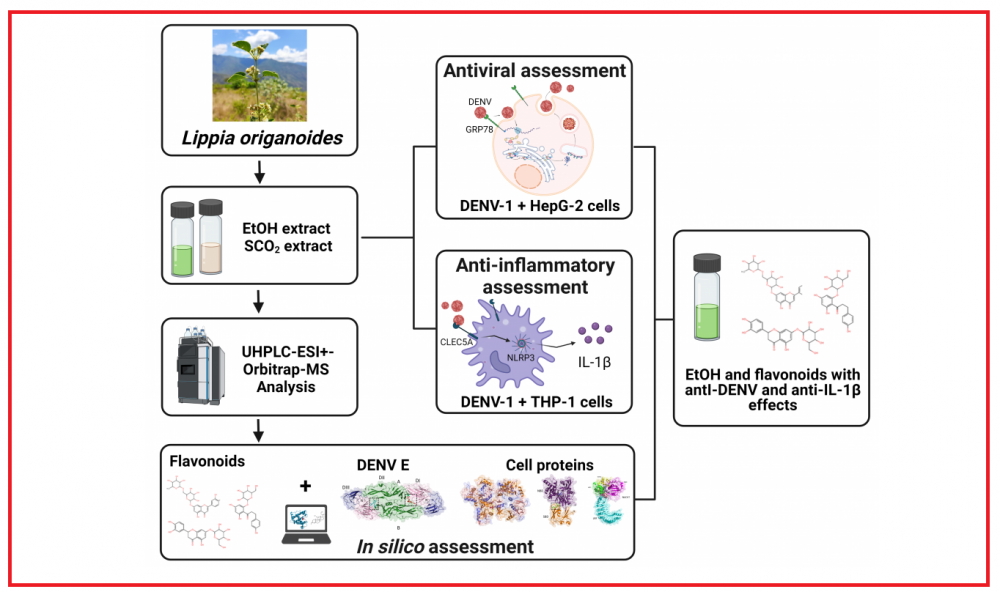
Despite intense research efforts, no approved effective therapies are available for dengue treatment. Standardized plant extracts could serve as potential candidates for developing plant-based treatments for dengue. We have compared the anti-dengue potential of ethanolic (EtOH) and supercritical (SCO2) extracts of Lippia origanoides Kunth (Verbenacea). The mode of antiviral action and the effect on the release of IL-β from DENV-1-stimulated macrophages (PMA/THP-1) were evaluated. In silico analyses were performed to predict molecular interactions between flavonoids identified in the UHPLC–ESI+–Orbitrap–MS analysis and target proteins. The EtOH extract showed a strong antiviral effect (IC50, 22 and 17 µg/mL; SI, 20 and 23) before and during DENV-1 adsorption to liver (HepG-2) cells. SCO2 showed a weak antiviral effect. EtOH, but not SCO2, reduced the level of IL-1β released from PMA/THP-1 cells by 45-55%. Flavonoid glycosides were identified in EtOH but not in SCO2. Seventeen flavonoids were predicted to bind to DENV E, GRP78, CLEC5A, and NLRP3 proteins involved in DENV replication and IL-1β production. The data provide a first step towards defining the potential of L. origanoides extract as a candidate for developing phytotherapeutics for dengue.
DOI http://doi.org/10.25135/rnp.401.2303.2720 Keywords Plant extracts Lippia origanoides dengue dengue virus macrophages cytokine DETAILS PDF OF ARTICLE © 2023 ACG Publications. All rights reserved.7) A New Lignan from the Leaves of Piper sarmentosum
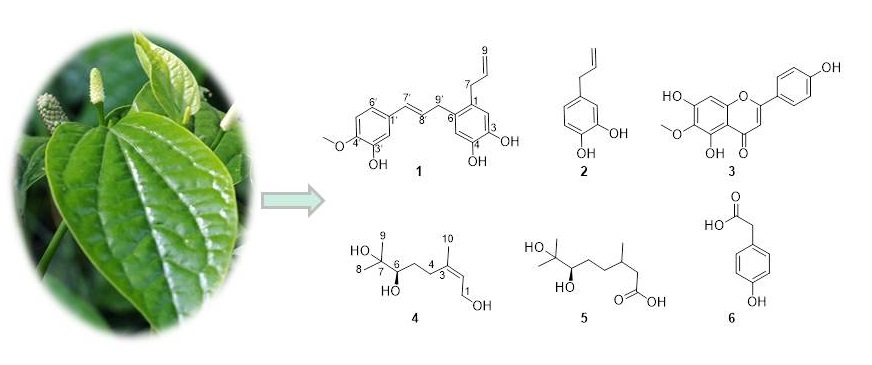
A new lignan, named 4'-methoxy-neotaiwanensol (1), together with five known compounds (2-6) were isolated from the leaves of the plant Piper sarmentosum. The known compounds consist of a phenylpropanoid (2), a flavonoid (3), two acyclic monoterpenoids (4 and 5), and a phenylacetic acid derivative (6). The structures of the know compounds were established via detailed analyses of the spectral data including NMR and HRESIMS data. The NMR data of 4 and 5 are new natural products and their NMR data in methanol-d4 were reported for the first time. The other known compounds were elucidated to be hydroxychavicol (2), salvitin (3), 4-hydroxy-benzeneacetic acid (6). In vitro, compounds 1 and 3 showed obvious antioxidant effects comparable to the positive control vitamin C, as well as better inhibitory effects on a-glucosidase than the reference acarbose.
DOI http://doi.org/10.25135/rnp.407.2306.2811 Keywords Lignan Piper sarmentosum 4-Methoxy-neotaiwanensol monoterpenoid DETAILS PDF OF ARTICLE © 2023 ACG Publications. All rights reserved.8) Chemical Composition of Different Parts of the Vitex agnus-castus L. Essential Oils and Their In-Vitro Cytotoxic Activities
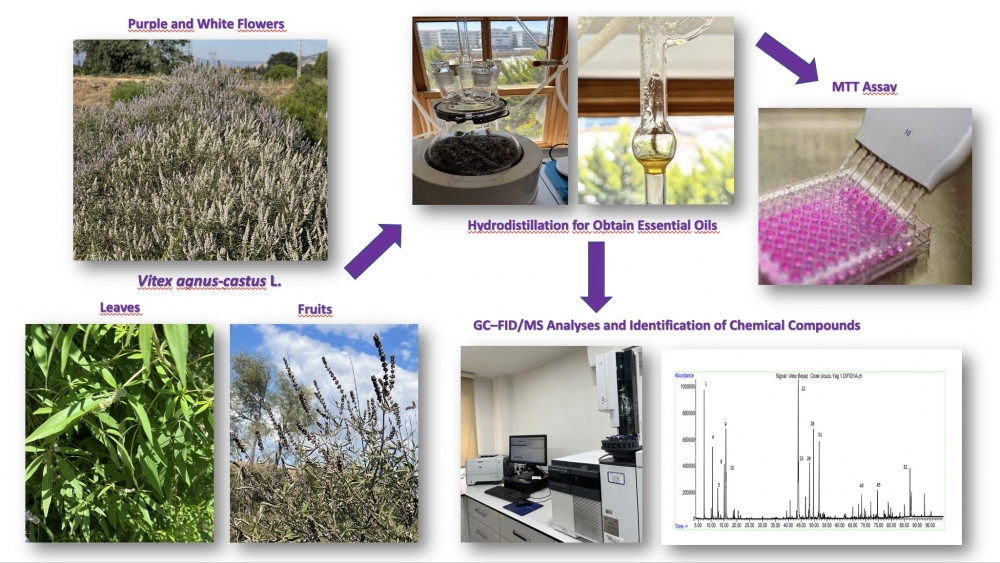
The essential oil (EO) compositions and chemotypes of the important ethnomedicinal plant Vitex agnus-castus L. flowers, leaves, and fruits collected from Türkiye (Balıkesir and İstanbul) were identified in the present study. Different parts of the V. agnus-castus EO’s in-vitro cytotoxic effects on the MCF-7 (human breast adenocarcinoma) and A549 (human lung carcinoma) human-origin cell lines were anaylzed in the current study. The composition of hydrodistiled EOs extracted from flowers, leaves, and fruits of V. agnus-castus were analyzed by GC–FID/MS. Monoterpene hydrocarbons and oxygenated monoterpene compounds were detected as the predominant component class of the V. agnus-castus. EOs extracted from Balıkesir region were defined as the “α-pinene-1,8-cineole” chemotype, while EOs extracted from İstanbul region were defined as the “sabinene-1,8-cineole” chemotype. Sesquiterpene hydrocarbons constituted more than 20% of the compounds in the EOs extracted from the flowers. To the best of our knowledge, this study is the first to analyze the in-vitro cytotoxic effects of flowers. This study is also the first to show the in-vitro cytotoxic effects of fruit, the most commonly used part of the plant, EO on the MCF-7 cell line. Balıkesir region’s EOs were observed as more potent -especially the purple flower’s IC50 is about 4.68 µg/mL on the MCF7 cell line- than İstanbul regions, which might be attributed to the higher amount of α-pinene, caryophyllene, and limonene content. Our results indicated that the V. agnus-castus EOs, which contain α-pinene, 1,8-cineole, caryophyllene, and limonene as major components, showed relatively high cytotoxic effects compared to the control groups on the MCF7 and A549 cell lines.
DOI http://doi.org/10.25135/rnp.404.2304.2761 Keywords Vitex agnus-castus L chasteberry essential oil cancer cytotoxicity DETAILS PDF OF ARTICLE © 2023 ACG Publications. All rights reserved.9) Comprehensively Revealing the Profile of Pistacia vera L. cv. Siirt Turpentine - Antioxidant, Antidiabetic, Anti-Alzheimer, and Antiglaucoma Effects
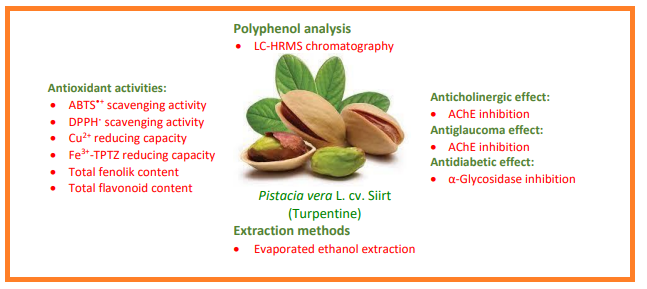
Pistacia species containing turpentine which has protective effects and used as a medicine against diabetes, and infections for a long time. To interpret the antioxidant capacities of turpentine from Pistacia vera L. cv. Siirt, 2,2’-azino-bis-3-ethylbenzthiazoline-6-sulphonic acid radical (ABTS•+) and 1,1-diphenyl-2-picrylhydrazyl free radical (DPPH∙), Fe3+-2,4,6-tris(2-pyridyl)-S-triazine (TPTZ) and Cu2+ reducing ability were studied and compared to reference antioxidants of BHT, BHA, α-Tocopherol, and Trolox. The IC50 of turpentine for ABTS•+ and DPPH∙ scavenging capacities were determined to be lower than reference antioxidant standards as 231.1 μg/mL and 346.6 μg/mL, consequently. The total flavonoid and phenolic contents in turpentine were measured as 12.5 mg GAE/g and 38.852 mg QE/g, respectively. For determination of antidiabetic, anti-Alzheimer, and antiglaucoma effects of turpentine, acetylcholinesterase (AChE), α-glycosidase and carbonic anhydrase II (hCA II) enzymes inhibition abilities of turpentine were performed, respectively. The IC50 values of turpentine extract against α-glycosidase, hCA II, and AChE enzymes were found as 2.04, 3.59 and 14.6 µg/mL, respectively. The quantity of protocatechuic acid and naringenin were determined using LC-MS/MS against 53 standards. The results clearly demonstrated polyphenolics in P. vera L. cv. Siirt turpentine is a natural product has potential usage in amelioration of glaucoma, AD, diabetes, and epilepsy.
DOI http://doi.org/10.25135/rnp.410.2305.2787 Keywords Phenolic compounds turpentine antioxidant α-glycosidase acetylcholinesterase carbonic anhydrase DETAILS PDF OF ARTICLE © 2023 ACG Publications. All rights reserved.10) Essential Oil Constituent, Antimicrobial Activity, and Mosquito Larvicidal Activity of Murraya glabra (Guillaumin) Swingle from Vietnam
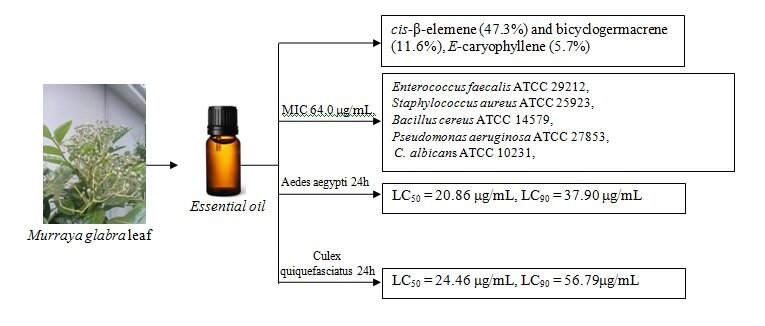
The present result showed that sesquiterpene hydrocarbons (78.3%) were the main class of compounds present in the essential oil hydrodistilled from the leaves of Murraya glabra (Guillaumin) Swingle from Vietnam. The major sesquiterpene compounds of the essential oil are cis-β-elemene (47.3%) and bicyclogermacrene (11.6%). In addition, E-caryophyllene (5.7%), (E, E)-α-farnesene (3.4%), ar-curcumene (3.3%) and α-zingiberene (3.0%) were the other sesquiterpenes present in sizeable amount. Oxygenated monoterpenes were not identified in the essential oil. The essential oil from the leaves of M. glabra displayed antibacterial activity against Enterococcus faecalis ATCC 29212, Staphylococcus aureus ATCC 25923, Bacillus cereus ATCC 14579, and Pseudomonas aeruginosa ATCC 27853, as well as anti-candidal action against C. albicans ATCC 10231, each with Minimum Inhibitory Concentration (MIC) value of 64.0 mg/mL. The corresponding median inhibitory concentration (IC50) values were 32.56 mg/mL, 32.58 mg/mL, 32.99 mg/mL, 32.45 and 32.44 mg/mL, respectively. Essential oil from the leaf of M. glabra exhibited larvicidal activity against Aedes aegypti and Culex quiquefasciatus with median lethal concentrations (LC50) values of 20.86 μg/mL and 24.46 μg/mL, at 24 h, respectively. The lethal concentration required to kill 90% of population exposed (LC90) values at the same test periods were 37.90 μg/mL and 56.79 μg/mL, respectively. The essential oils may be further considered and investigated as a source of natural products.
DOI http://doi.org/10.25135/rnp.406.2305.2779 Keywords Murraya glabra gram-positive bacteria gram-negative bacteria Aedes aegypti Culex uinquefasciatus DETAILS PDF OF ARTICLE © 2023 ACG Publications. All rights reserved.11) Callignan A, A New Neolignan from the Leaves of Callicarpa kwangtungensis
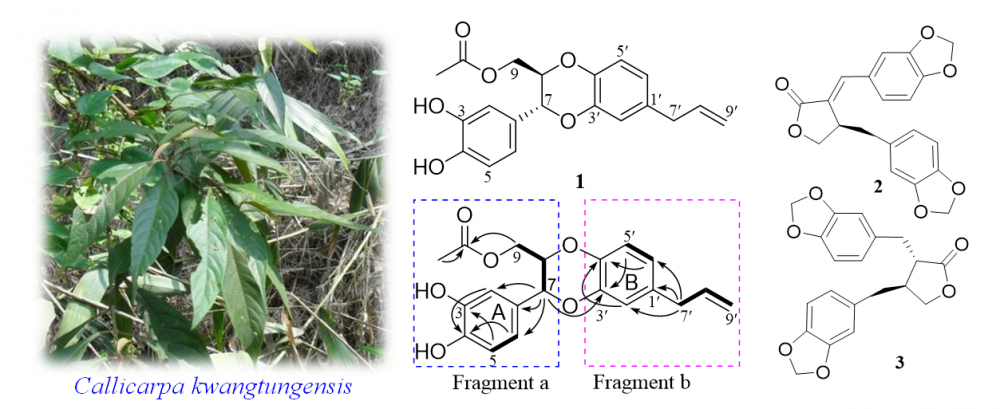
In the current study, a new lignan (1), named callignan, as well as two known ones (2 and 3), were obtained from the EtOAc extract of the leaves of Callicarpa kwangtungensis. The structure elucidation of 1 was conducted by detailed interpretation of the 1D and 2D NMR spectroscopic data. Optical rotation of compound 1 and ECD data revealed that the compound was a racemic compound. Compounds 1-3 showed moderate effects with IC50 values of 46, 29, and 42 mM on NO production in LPS-induced RAW 264.7 cell inflammation model..
DOI http://doi.org/10.25135/rnp.408.2307.2832 Keywords Callicarpa kwangtungensis callignan A neolignan DETAILS PDF OF ARTICLE © 2023 ACG Publications. All rights reserved.12) Nocardiopyrone C, a New Antimicrobial Pyran-2-one Derivative from a Marine-derived Actinomycete Strain Nocardiopsis aegyptia ZSN1
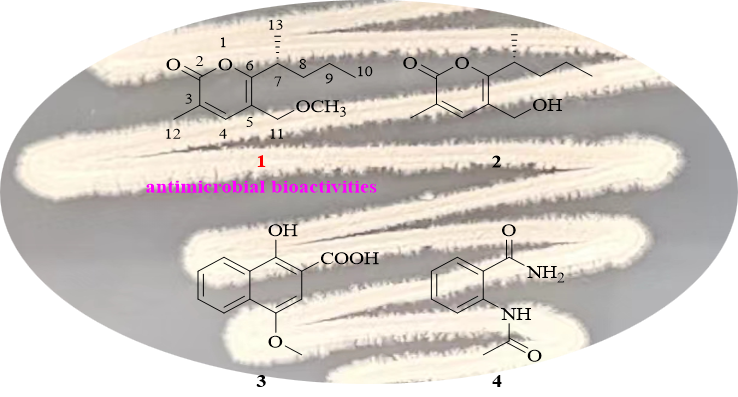
A new pyran-2-one derivative, Nocardiopyrone C (1), and three known compounds, Nocardiopyrone B (2), 1-hydroxy-4-methoxy-2-naphthoic acid (3), and 2-(aminocarbonyl)-phenylcarbamate (4) were identified from the marine-derived Nocardiopsis aegyptia ZSN1. The chemical structure of the novel compound (1) was ascertained as (7R)-5-(methoxymethyl)-3-methyl-6-(pentan-2-yl)-2H-pyran-2-one using HRESIMS data, spectroscopic data, and ECD calculations. All four isolated compounds displayed antimicrobial activity, with the new compound 1 having the same MIC value of 50.0 µM against E. coli, S. aureus, and C. albicans.
DOI http://doi.org/10.25135/rnp.405.2304.2763 Keywords Nocardiopsis aegyptia nocardiopyrone C antimicrobial DETAILS PDF OF ARTICLE © 2023 ACG Publications. All rights reserved.13) Two New Trienoic Acid Derivatives from Marine-derived Fungus Penicillium oxalicum BTBU20213011
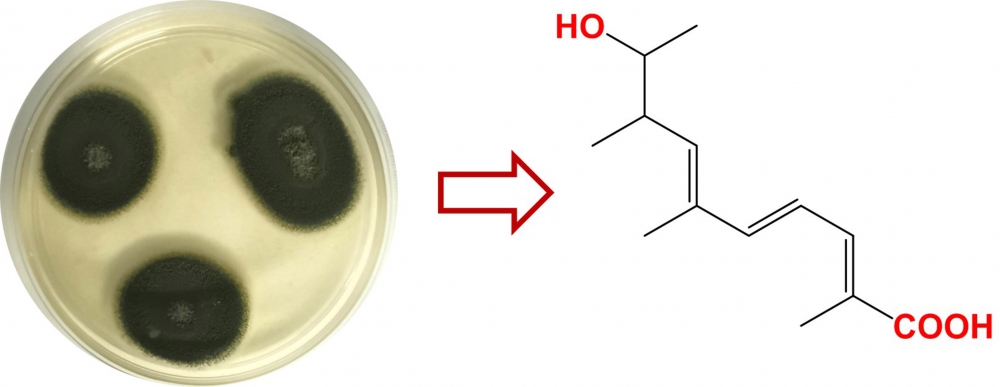
Two new trienoic acid derivatives, namely penioxa acids A (1) and B (2), have been isolated from the marine-derived fungus strain Penicillium oxalicum BTBU20213011. Their structures were determined by extensive analysis of spectroscopic data, including 1D and 2D NMR, and HRESIMS.
DOI http://doi.org/10.25135/rnp.400.2303.2737 Keywords Penicillium oxalicum BTBU20213011 trienoic acid derivatives marine-derived fungus DETAILS PDF OF ARTICLE © 2023 ACG Publications. All rights reserved.